Abstract
Karate is a Japanese martial art, a fight with empty hands. Etymologically, means empty and means hand. Karate is composed of two parts: kata (form) and kumite (fight). Both of them have individual and team competitions. Regardless of their nature, each of the competitions has techniques and basic rules according to which the referees analyse the level of the athlete and, in concordance with this, they give the point. The qualities that define the level of sports performance are: technique, strength, speed, balance, coordination. These qualities, from our point of view, should be developed at the same level on both left and right sides for improving the efficiency. This paper proposes an objective demonstration that the non-dominant side can be trained using exercises that are specific to karate, within complementary training. During this scientific work, there were achieved measurements at the muscular and neuromuscular level too, using the Electromyography (EMG), Tensiomyography (TMG) and the Conditions Simulator. The complementary training sessions were based on neuromuscular control exercises, which were performed on the left and right sides. The initial and final tests were performed on the straight punch (choku zuki) from the natural position (shizentai). The results showed an important improvement in the non-dominant side on both of the measured levels.
Keywords: Karate, neuromuscular coordination, dominant side, conditions simulator
Introduction
A Japanese martial art founded by Gikin Funakoshi, karate has become lately a sport (Funakoshi,
1998: 97). Masathoshi Nakayama and Hidetaka Nishiyama are those who established the concept of
sport in karate, and the competition rules too (Nishiyama & Brown, 1992: 14).
The most important competitions are those of kata (form), individual or team, and kumite (fight),
also individual and team. For each of these competitions, there are rules which help to evaluate the
level of the athletes. The technical executions, rhythm, speed, distance estimation (control) are criteria
for making the difference between athletes. Since the competition level is higher and higher, coaches
try to increase the efficiency of training sessions. We consider that the training of the non-dominant
side of the athletes is not enough developed yet.
Lafon (1963) said that laterality means “the functional inequality of the left or right side of the
body”. The inequality depends (as we will show later) on the way the two brain hemispheres are used.
The left brain hemisphere controls the right side and vice versa. In this work, we intend to demonstrate
that the non-dominant side of the body can be trained too. We can do that using complementary
exercises, in the laboratory, in a much shorter time than in the classical training.
Laterality can be seen and revealed (Pătru et al., 2015: 6) even to the long-experienced high level
athletes, and their preparation tries to diminish this deficiency, mainly in the first years of training. For
the high level, we can speak about favourite combinations, but the possibility to be attacked or the
opportunity to attack on the non-dominant side may occur at any moment. As there are many and
diverse attack-defence possibilities, the chances of reaching a high level of performance are increasing.
This is the reason why attempts are made to increase the level of neuromuscular control on the non-
dominant side as near as possible to the dominant one.
The facilities offered by the conditions simulator equipment “are in connection with the athlete’s
possibilities of information during each execution on the achievement of the target force centimetre by
centimetre, millisecond by millisecond, with the information provided to the coach about the volume
and quality throughout the training” (Hillerin, Schor, & Stupineanu, 1996). This is the reason why we
have chosen this complementary type of training, pursuing the perfection of executions on the non-
dominant side and a shorter time in reaching the target, too.
Materials and methods
The research hypothesis. During complementary training sessions, the neuromuscular control on the
non-dominant side can be improved in high level athletes.
The methods used: bibliographic, observation, experiment, case study, graphical methods.
In conducting this research, we administered an initial test and a final one. The purpose was to
determine the complementary training effects on the investigated subject. Testing and training were
done on the wireless conditions simulator based on the CASINOR® (
) concept. We have chosen this equipment because it gives freedom for typical karate
movements (Fig. 1). The tests and training sessions were performed in the biometry laboratory of INCS
(National Institute for Sport Research) in Bucharest. The researched subject was a black belt 2 DaN, 22
years old, female, a multiple national, European and World champion, with 15 years of experience,
practicing kata and kumite. The athlete is right-handed.
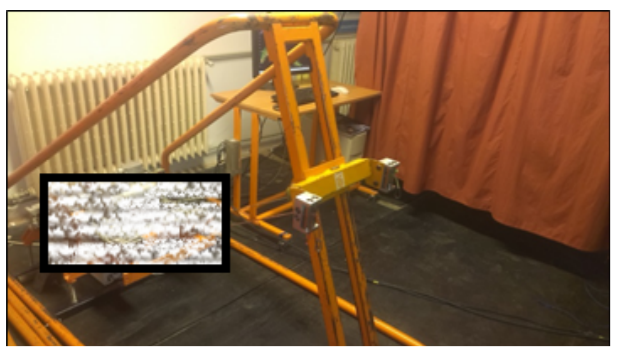
The initial and final tests consisted in the execution of 40 chokuzuki strikes (straight punches) from
the shizentai position (the natural oe, where the feet are shoulder width apart). The strikes where done
in series of 20 with each arm (left and right). To monitor punches, the athlete had to work on the
conditions simulator with 80% break and 4 DaN power. Her task was to follow an established
execution model for each execution. The athlete received real-time visual feedback on each execution.
At the same time, the activity of some muscular groups was recorded with an electromyograph, using
the DelsysTrigno™ Wireless System (1) equipment. Complementary training was designed to improve
the efficiency of the non-dominant side and lasted 7 days. In the first 2 sessions, the subject performed
4 series of 20 consecutive strikes with the right arm and 8 with the left one. During the next 5 sessions,
the series where of 10 strikes in the same working conditions (4 daN power, 80% break); the training
program was customized taking into account the anthropometric particularities of the subject (52 kg
weight, 167 cm height). For measuring the electric muscular activity, we used a 16-sensor
electromyograph, TrignoTM Digital Wireless EMG System (Fig. 2).
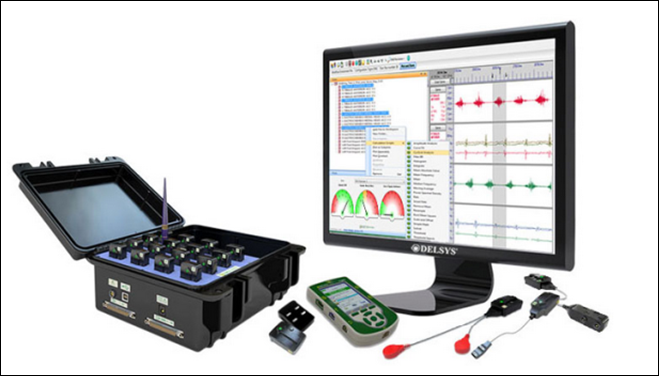
The Trigno sensors where fixed straight to the skin, on the belly muscle, with a special adhesive
band (TrignoTM Wireless EMG, 2015). Taking into account the specific punch chosen for this
experiment, we selected the following muscle groups: dorsal, trapeze, deltoid, finger extensors,
brachial biceps, brachioradialis and finger flexors. While we monitored the quality of neuromuscular
control and how the established muscle groups were functioning, the acquisitions were being done
separately, on the right and left sides.
During this scientific stage, two tests were performed (the initial and final ones) on the conditions
simulator. The task of the athlete was to make 20 straight punches with the right arm – choku zuki –
from a natural position (shizentai), and the same thing with the left one. The purpose was to follow a
graphical model with a constant force value - 4daN. The acquisition to the muscular level was achieved
in the same time with the EMG. Between the two tests, a number of 7 complementary training sessions
were performed using the specific move on the left and right sides. The number of repetitions on the
non-dominant side was two times bigger than on the dominant one. For all the period the
complementary training was done, the athlete did not interrupt her normal training. This was continued
as planned.
Results
Figure 3 shows the initial test (left) and the final one (right) recorded on the conditions simulator for
the right arm strikes (up) and the left one (down). Concerning the result of executions on the conditions
simulator, in the initial test, the neuromuscular control level is lower on both sides. Even if the athlete
succeeds till the end to achieve the task, she has some problems with distance estimation and her
constancy in performing the strikes. In the final test, the neuromuscular control level is considerably
better. The athlete can reach the task, removing the distance-estimation and constancy-related
problems. In the final test, it can be seen a small variation in the executions, almost similar for both
sides. In Figure 4, there are graphically represented the variations in the electric surface potentials
recorded for the tested muscular groups. In Figure 5, there are specified the tested muscular groups,
and the identification colours are shown in Figure 4.
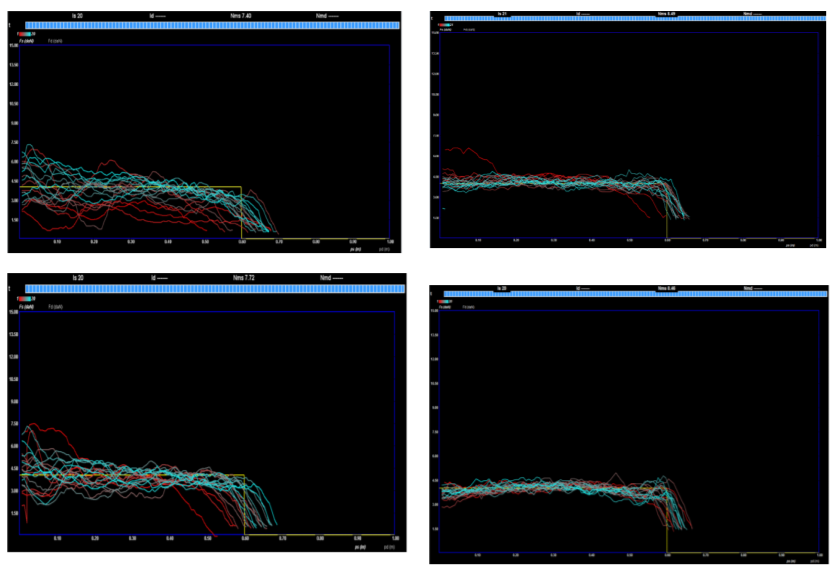
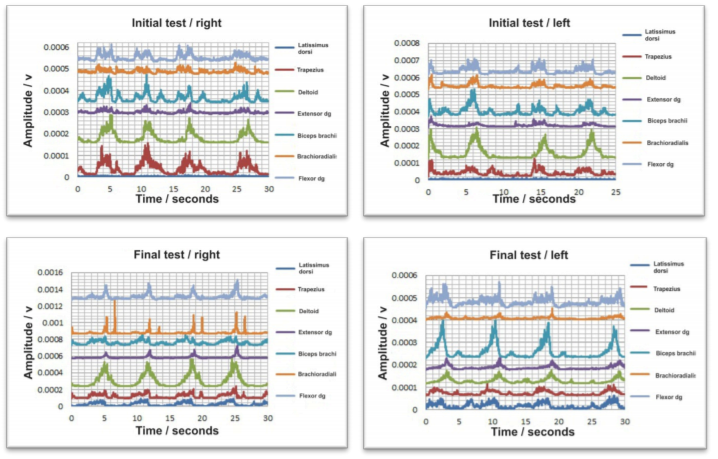
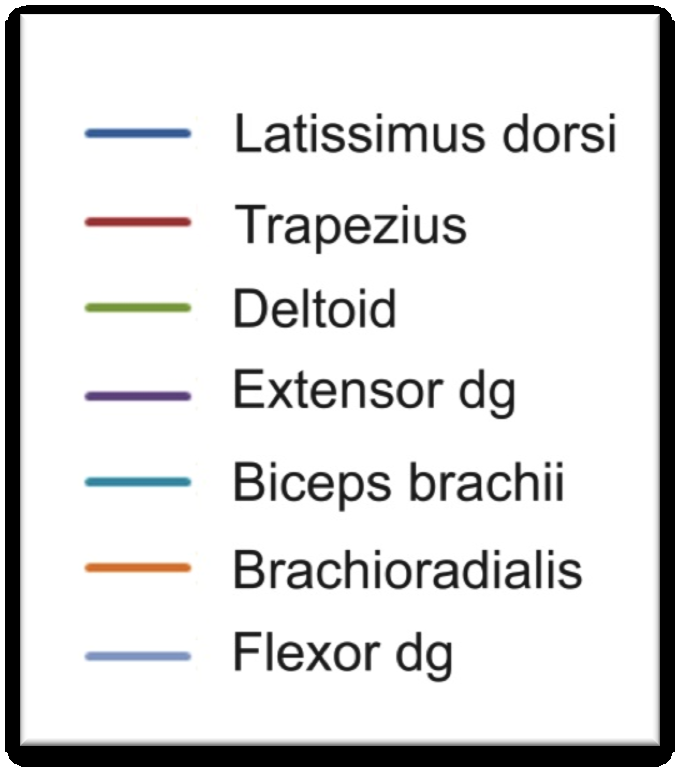
Concerning the muscle activity, in the initial test, the dorsal muscle did not have an important
contribution to making the move. Its part of involvement was taken by the trapeze muscle, where the
muscular activity was intense. This may lead to an alteration of the moves and involves the risk of
premature tiredness.
In the final test, the two muscular groups start working together. Their contribution – the trapeze
and dorsal muscles – to achieving the move is equal. If in the initial test the electric curves of the
investigated muscular groups suggested an imprecision in movement execution, a lower control, the
final test shows the benefit of the complementary control training, the muscular constriction curves
revealing a controlled movement, an exquisite muscular control.
Concerning the result of executions on the conditions simulator, in the initial test, the neuromuscular
control level is low. Even if the athlete succeeds till the end to achieve the task, she has some problems
with distance estimation and her constancy in performing the strikes. In the final test, the
neuromuscular control level is considerably better. The athlete can reach the task, removing the
distance- estimation and constancy-related problems.
Concerning the muscular activity, it has been shown that, in the initial test, the same problem arises
on the right side – lack of participation of latissimus dorsi in executing the move, without the trapeze to
take over the task. It is shown the lack of control in doing the move, too, and a weak participation of
the finger extensors. The final test shows the participation of latissimus dorsi in the move, but with a
slight sync mismatch.
In the final test, it is observed the benefit of the training; on the left side, the control is still poor in
comparison with the right one, mainly on flexor and dorsal muscles.
The neuromuscular control of the strikes on the left side shows that the problems on the right side
can be found here too. The initial test executions show the same problems with estimating the distance
and execution constancy. The final test executions have been adjusted, the quality of neuromuscular
executions on the non-dominant side increasing compared with the initial test on the same side.
Discussions and conclusions
After the experimental part of this study, we can see the following:
There has been an important increase in the quality of neuromuscular control on both the dominant
and non-dominant sides.
If initially the estimation of distance and the constancy of the strike were not very good, after the
training on the conditions stimulator, both of them have improved on both sides, the right and left ones.
There has been a decrease in the differences related to the quality of execution on the right and left
sides. This might be due to the complementary training sessions for increasing the quality of technical
execution on both the right and left arms.
After applying the complementary training program, we can see a modification in the muscular
synergy through the involvement in the move of some muscular groups that have never been used
before. It is about the dorsal muscle that was initially inactive and the trapeze muscle, which
compensate the activity. The fact that the dorsal muscle works determines a diminution in the activity
of the trapeze muscle, which leads to a more efficient strike and avoiding the onset of tiredness.
The muscular effort on the right side in the final test was more intense than on the left one. This
might be a consequence of the muscle soreness.
Acknowledgements
The study is achieved and published under the aegis of the National University of Physical Education and Sports of Bucharest, as a partner of the programme co-funded by the European Social Fund within the Operational Sectoral Programme for Human Resources Development 2007-2013 through the project Pluri- and interdisciplinarity in doctoral and post-doctoral programmes Project Code: POSDRU/159/1.5/S/141086, its main beneficiary being the Research Institute for Quality of Life, Romanian Academy.
References
Funakoshi, G. (1998). Karate-do Calea mea în viață. București: Garell.
Hillerin, P., Schor, V., & Stupineanu, I. (1996). Ergosim,marcă, ansamblu de concepte sau aparat de pregătire? Știinţa Sportului, 3, 7-41.
Lafon, R. (1963), Vocabulaire de Psychopedagogie et de Psychiatrie de l ҆Enfant, Paris.
Nishiyama, H., & Brown, R. (1992), Karate - The Art of “Empty Hand” Fighting. Tokyo: Rutland, Vermont, Charles E.: Tuttle Company.
Pătru, L., Negulescu, I., Băițel, I., & Angelescu, L. (2015). Laterality emphasizing through cinematic parameters analysis on karate Shotokan athletes. 11th International Scientific Conference eLearning and Software for Education, Bucharest, April 23-24. 2015, 10.12753/2066-026X-15-222.
TrignoTM Wireless EMG. (2015). Retrieved from http://www.donnamaria.ro/suport/Aplic/Simulator3/; http://www.delsys.com/products/wireless-emg/
Copyright information

This work is licensed under a Creative Commons Attribution-NonCommercial-NoDerivatives 4.0 International License.
About this article
Publication Date
10 June 2016
Article Doi
eBook ISBN
978-1-80296-010-5
Publisher
Future Academy
Volume
11
Print ISBN (optional)
-
Edition Number
1st Edition
Pages
1-509
Subjects
Sports, sport science, physical education
Cite this article as:
Patru, L., Negulescu, I., Ciurea, C., & Angelescu, L. (2016). The Effects of the Complementary Training on Coaching the Non-Dominant Side in Karate Shotokan. In V. Grigore, M. Stanescu, & M. Paunescu (Eds.), Physical Education, Sport and Kinetotherapy - ICPESK 2015, vol 11. European Proceedings of Social and Behavioural Sciences (pp. 398-404). Future Academy. https://doi.org/10.15405/epsbs.2016.06.55

